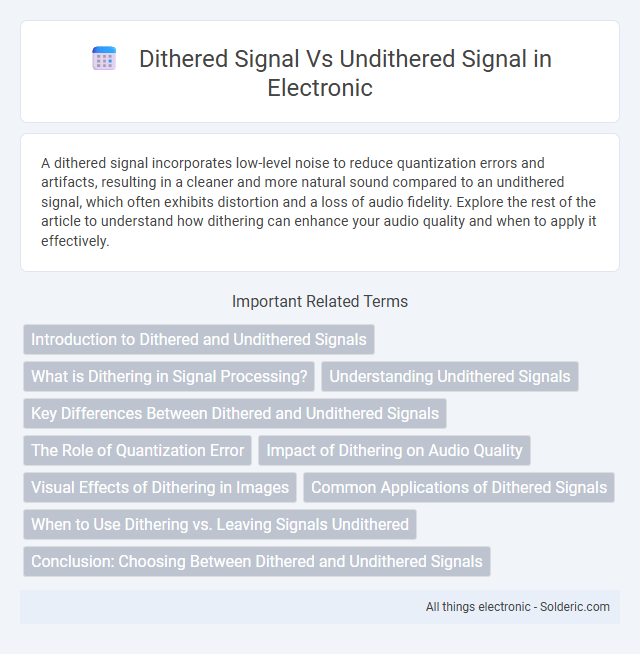A dithered signal incorporates low-level noise to reduce quantization errors and artifacts, resulting in a cleaner and more natural sound compared to an undithered signal, which often exhibits distortion and a loss of audio fidelity. Explore the rest of the article to understand how dithering can enhance your audio quality and when to apply it effectively.
Comparison Table
| Feature | Dithered Signal | Undithered Signal |
|---|---|---|
| Definition | Signal enhanced with low-level noise (dither) to reduce quantization errors. | Raw signal without added noise, directly quantized. |
| Quantization Noise | Noise shaped and randomized, minimizing distortion. | Noise appears as correlated distortion artifacts. |
| Sound Quality | Smoother, more natural sound with reduced harmonic distortion. | Potentially harsh and metallic sound due to quantization errors. |
| Dynamic Range | Improved effective dynamic range in low-level signals. | Lower effective dynamic range with audible noise floor. |
| Use Case | Professional audio mastering and high-fidelity digital audio conversion. | Basic digital recording without noise shaping. |
| Complexity | Requires additional processing to add dither noise. | Simple direct quantization process. |
Introduction to Dithered and Undithered Signals
Dithered signals incorporate low-level noise to minimize distortion and quantization errors during digital signal processing, enhancing audio fidelity and image quality. Undithered signals lack this deliberate noise, often resulting in audible artifacts and less accurate representation of the original signal. Understanding the difference helps you choose the right technique for cleaner, more accurate digital output.
What is Dithering in Signal Processing?
Dithering in signal processing is a technique used to minimize quantization errors by adding low-level noise to a signal before digital conversion, improving the perceived audio or image quality. A dithered signal exhibits reduced distortion and smoother transitions between levels, while an undithered signal may produce quantization noise and harsh artifacts. You benefit from dithering especially in audio mastering and digital imaging, where preserving detail and reducing quantization errors are critical.
Understanding Undithered Signals
Undithered signals exhibit quantization errors that manifest as distortion and tonal artifacts due to the absence of noise shaping techniques. This results in reduced audio fidelity, with quantization noise becoming more noticeable, especially in low-level signals. Understanding undithered signals helps you recognize the importance of dithering to enhance sound quality by minimizing these unwanted distortions.
Key Differences Between Dithered and Undithered Signals
Dithered signals incorporate a low-level noise intentionally added to reduce quantization errors and improve audio or image quality during digital conversion. Undithered signals lack this noise, often resulting in more noticeable distortion and quantization artifacts, especially at low amplitude levels. The key differences lie in signal fidelity, with dithered signals providing smoother, more natural outputs while undithered signals risk audible or visible imperfections.
The Role of Quantization Error
Quantization error plays a crucial role in distinguishing dithered signals from undithered signals by introducing noise that masks distortion in digital audio processing. In undithered signals, quantization error causes non-random distortions, leading to audible artifacts and reduced sound quality. You can improve audio fidelity by applying dithering, which adds subtle noise to decorrelate quantization error and produce a more natural, smooth sound.
Impact of Dithering on Audio Quality
Dithering significantly reduces quantization distortion and noise artifacts in digital audio signals, resulting in smoother sound quality and preserving subtle audio details during low-level signal processing. Undithered signals often exhibit audible quantization errors, leading to harshness and reduced fidelity, especially in quiet passages. By introducing a controlled noise floor, dithering enhances the perceived dynamic range and clarity of audio, making it essential for professional audio production and mastering.
Visual Effects of Dithering in Images
Dithered signals create a visually smoother gradient by distributing quantization errors across pixels, reducing banding artifacts commonly seen in undithered signals. Your images display improved tonal transitions and finer textures, enhancing perceived detail despite limited color depth. This technique is essential in digital imaging to simulate continuous tones and maintain visual quality on lower-bit displays.
Common Applications of Dithered Signals
Dithered signals are widely used in digital audio processing to reduce quantization errors and minimize distortion during analog-to-digital conversion. Common applications include audio recording, music production, and digital signal processing where maintaining sound quality and clarity is critical. Dithered signals improve dynamic range and preserve subtle audio details, making them essential in professional audio mastering and consumer electronics like digital music players.
When to Use Dithering vs. Leaving Signals Undithered
Dithering is essential when converting high-resolution audio signals to lower bit depths to reduce quantization errors and avoid digital distortion, especially in music production and mastering processes. Leaving signals undithered is acceptable in situations where the signal remains at full resolution or when noise shaping is unnecessary, such as in raw data recording or post-production stages with minimal bit-depth reduction. Proper application of dithering enhances audio quality by preserving subtle details and preventing audible artifacts during digital signal processing.
Conclusion: Choosing Between Dithered and Undithered Signals
Choosing between dithered and undithered signals depends on the specific application and desired audio quality. Dithered signals introduce low-level noise to reduce quantization distortion and improve perceived sound clarity, especially in low-level or highly dynamic audio content. Undithered signals may offer cleaner audio in high-quality, high-bit-depth environments but risk audible quantization artifacts in lower bit-depth conversions.
Dithered signal vs undithered signal Infographic

 solderic.com
solderic.com